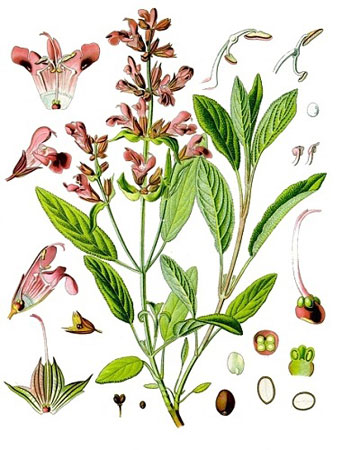Salvia officinalis – Sage officinalis
Long-term shrub height of 50-70 cm, families gubotsvetnыh (Lips). The plant is cultivated as a medicinal plant in the southern climates. For medical purposes use the leaves sage.

Salvia officinalis – chemical composition
The sage leaves contain flavonoids, alkaloidы, tannins and resinous substances, organic acid (oleanolic, ursolic, chlorogenic et al.), vitamin P and PP, bitterness, volatile, and a substantial amount of essential oil, containing pinene, Cineol, thujone, ʙorneol, Salvia and other terpene compounds.
Salvia officinalis – Pharmacological properties
Anti-inflammatory and antimicrobial properties of sage related to the content of tannins in the leaves and flavonoid compounds, as well as the presence in the aerial parts of the plant essential oil, and vitamin P and PP. Antimicrobial activity was most pronounced plants against Gram-positive strains of bacteria and to a lesser extent galenic sage effect on gram-negative strains of microorganisms.
Anti-inflammatory effect of sage due to lower permeability of the walls of blood vessels and capillaries under the influence of drugs, as well as the presence of the plant hemostatic properties. The combination of these properties is significantly potentiates the overall impact on the main elements of the inflammatory process, including the possibility of inhibiting the activity of pathogenic microflora.
Besides, experimentally found, that the sage leaves increase the secretory activity of the gastrointestinal tract due to the presence of a plant whose grief. Galenic form and the plants have slight antispasmodic effect. It is well known property of leaves of the plant to inhibit sweating.
Salvia officinalis – medical applications
Salvia herbal medicines used for inflammatory diseases of the oropharynx, nose, throat and upper respiratory tract, Considering binders, anti-inflammatory, disinfectants and Phytoncidal properties of the plant. Sage leaves are used as a tincture for rinsing, inhalations, lotions and wet turundas.
Infusions of sage are also used in inflammatory diseases of the skin, for the treatment of festering wounds and ulcers, for mild burns and frostbite. With the purpose of treatment using gauze, soaked infusion of sage, appoint general or local baths with infusion.
There is clinical experience with herbal medicines sage in gastritis and gastric ulcer and duodenal ulcer with reduced secretory activity of the gastrointestinal tract and the acidity of gastric juice, as well as patients with a propensity to spastic states of the stomach and intestines. Assign also sage in inflammation of the bladder. Separately sage herbal medicines are rarely used, sage leaves usually consist of complex fees.
Sage reduces sweating; This property is used in climacteric, in some fevers, tuberculosis. The ability of drugs to inhibit sage lactation in nursing mothers requires further study.
Salvia officinalis – Dosage Forms, Dosing and Administration
Tincture of sage - Clear liquid greenish-brown color, typical aromatic odor and taste. Preparing tincture 1:10 on 70% alcohol. It is used for rinsing.
Infusion of sage leaves: 10 g (2 tablespoons) raw material is placed in an enamel bowl, Pour 200 ml (1 glass) hot boiled water, was heated in boiling water (in a water bath) 15 m, cooled at room temperature for 45 m, filter. The remaining raw materials squeeze. The volume of the resulting infusion donodyat boiling water (in a water bath) 15 m, cooled at a cool place 2 d.
The infusion is used as an emollient and anti-inflammatory agent.
Sage leaves stored in a dry, cool place.
